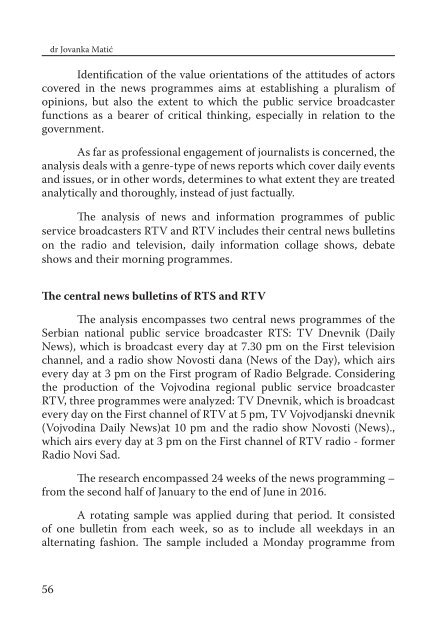Create successful ePaper yourself
Turn your PDF publications into a flip-book with our unique Google optimized e-Paper software.
dr Jovanka Matić<br />
Identification of the value orientations of the attitudes of actors<br />
covered in the news programmes aims at establishing a pluralism of<br />
opinions, but also the extent to which the public service broadcaster<br />
functions as a bearer of critical thinking, especially in relation to the<br />
government.<br />
As far as professional engagement of journalists is concerned, the<br />
analysis deals with a genre-type of news reports which cover daily events<br />
and issues, or in other words, determines to what extent they are treated<br />
analytically and thoroughly, instead of just factually.<br />
The analysis of news and information programmes of public<br />
service broadcasters RTV and RTV includes their central news bulletins<br />
on the radio and television, daily information collage shows, debate<br />
shows and their morning programmes.<br />
The central news bulletins of RTS and RTV<br />
The analysis encompasses two central news programmes of the<br />
Serbian national public service broadcaster RTS: TV Dnevnik (Daily<br />
News), which is broadcast every day at 7.30 pm on the First television<br />
channel, and a radio show Novosti dana (News of the Day), which airs<br />
every day at 3 pm on the First program of Radio Belgrade. Considering<br />
the production of the Vojvodina regional public service broadcaster<br />
RTV, three programmes were analyzed: TV Dnevnik, which is broadcast<br />
every day on the First channel of RTV at 5 pm, TV Vojvodjanski dnevnik<br />
(Vojvodina Daily News)at 10 pm and the radio show Novosti (News).,<br />
which airs every day at 3 pm on the First channel of RTV radio - former<br />
Radio Novi Sad.<br />
The research encompassed 24 weeks of the news programming –<br />
from the second half of January to the end of June in 2016.<br />
A rotating sample was applied during that period. It consisted<br />
of one bulletin from each week, so as to include all weekdays in an<br />
alternating fashion. The sample included a Monday programme from<br />
NEWS AND INFORMATION PROGRAMMING OF THE SERBIAN NATIONAL AND<br />
VOJVODINA REGIONAL PUBLIC SERVICE BROADCASTERS (RTS AND RTV)<br />
the first week, a Tuesday programme from the second week, Wednesday<br />
programme from the third week, etc., then again a Monday programme<br />
from the eighth week. 2 In the overall sample, each weekday was included<br />
three or four times.<br />
The research used the quantitative-qualitative content analysis.<br />
The unit of analysis was a news item. Each news item was classified<br />
according to the following categories – the placement, length, genre, the<br />
motive for reporting, audio-visual presentation and general topic (that<br />
is, thematic group) being discussed (politics, economy, culture, world<br />
events, etc.). When it comes to the news actors, a more detailed analysis<br />
was carried out, registering every actor whose activities or opinions<br />
were presented, as well as the actors who were the objects of their value<br />
judgments and qualifications (positive, negative, neutral).<br />
Overall, 2237 news reports were analyzed from the central news<br />
bulletins: 528 items of TV Dnevnik on RTS channel, 512 items of Novosti<br />
dana on Radio Belgrade, 354 items of TV Dnevnik on RTV channel, 448<br />
items of TV Vojvodjanski dnevnik on RTV channel and 395 items of the<br />
RTV radio programme called Novosti.<br />
2<br />
In couple of cases this pattern was not followed, in order to add certain programmes<br />
that were broadcasted on particular days, such as 29 th February – a leap year day, 8 th<br />
March – Women’s Day, 12 th March – the anniversary of assassination of the Serbian<br />
Prime Minister in 2003, and 1 st May – Labour Day. The programmes on these days<br />
were considered to be of special social significance, therefore thought to be more<br />
representative of the way public media service relates to the public needs. Whenever the<br />
sample included one of these “special” days, it was continued with the rule of including<br />
every eighth programme.<br />
56 57


